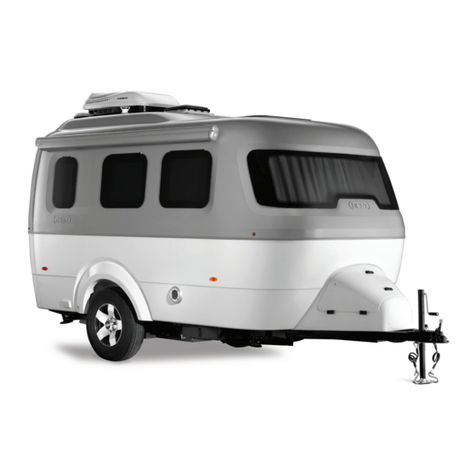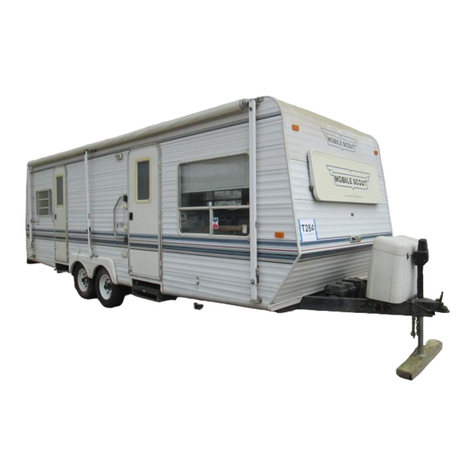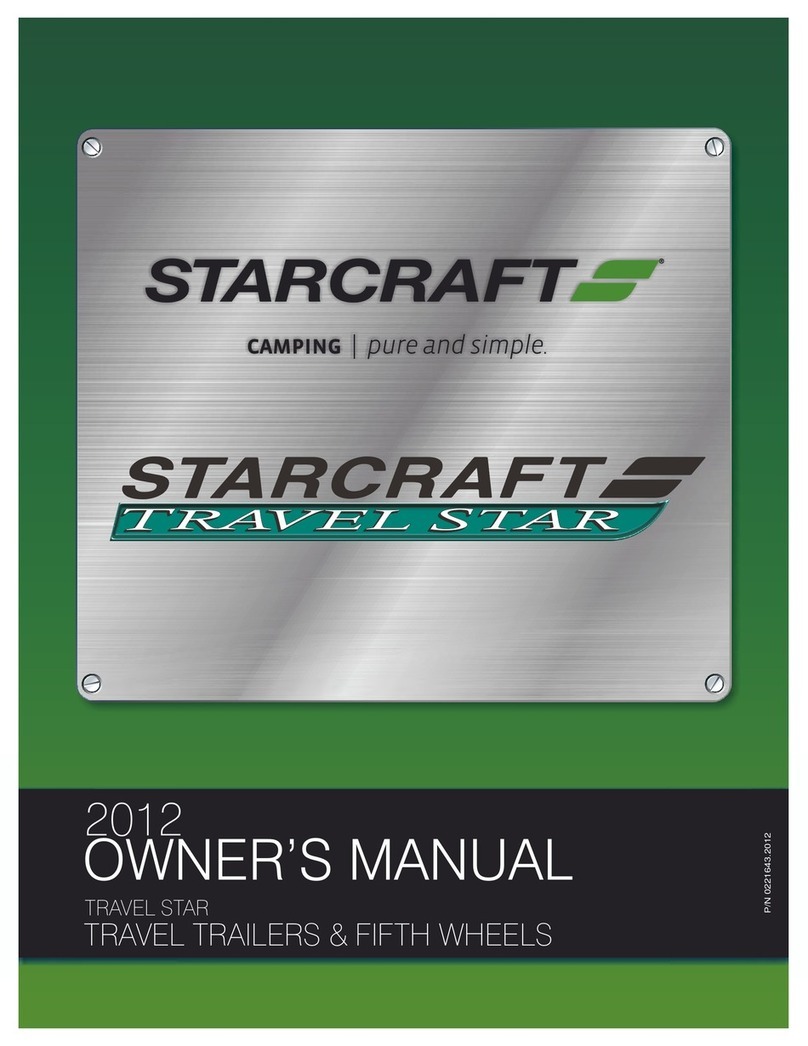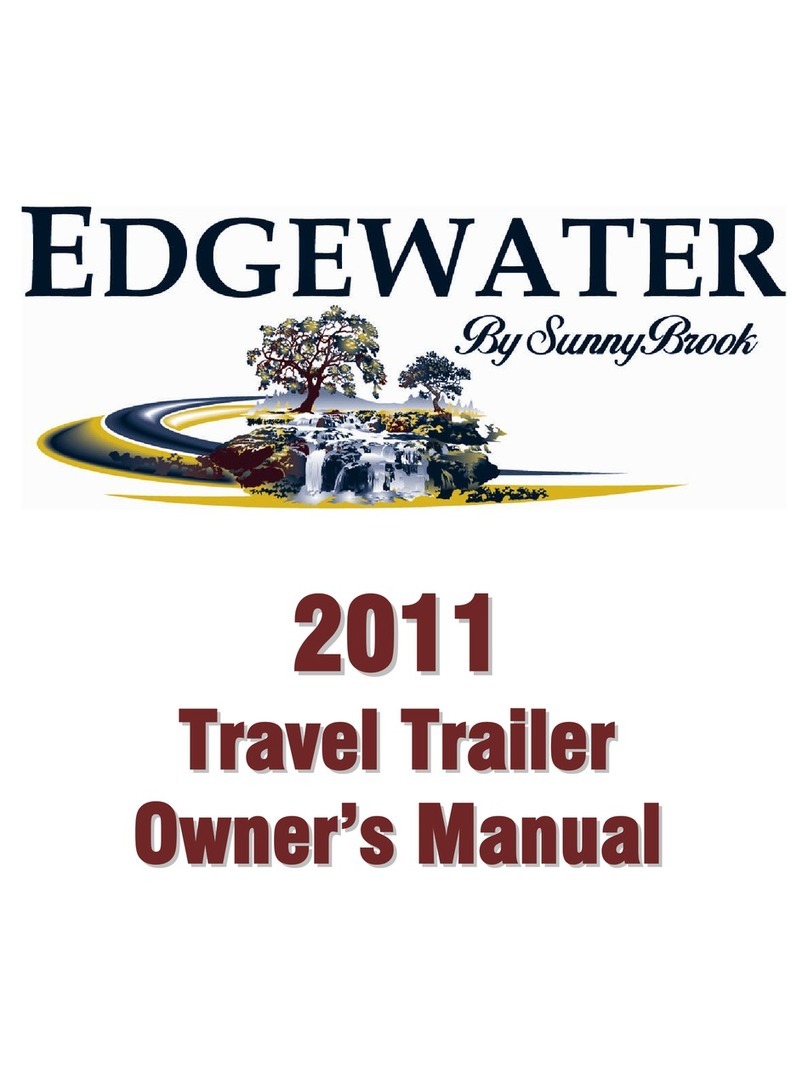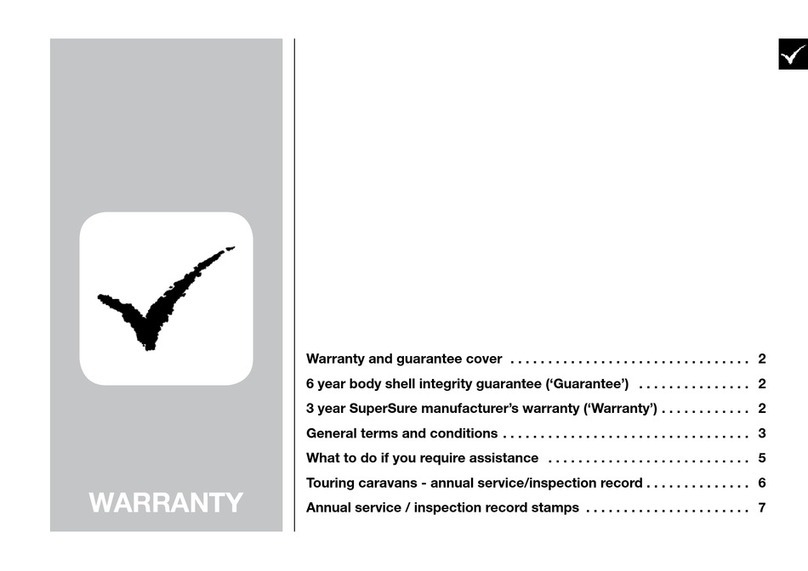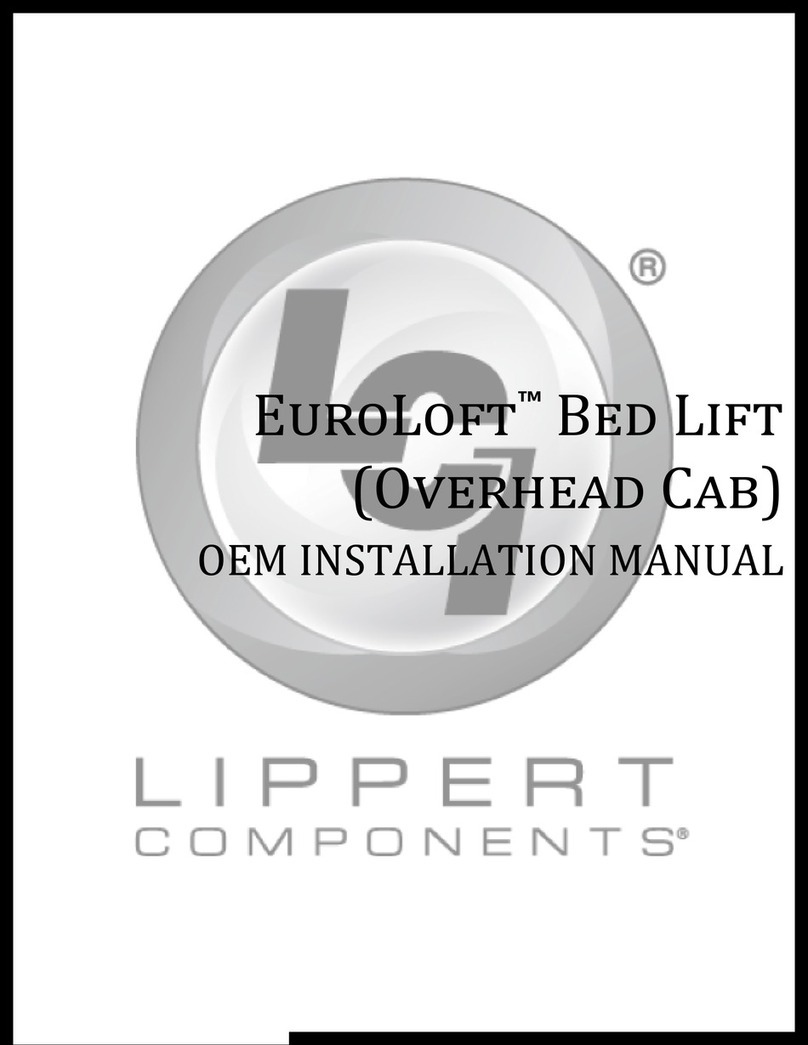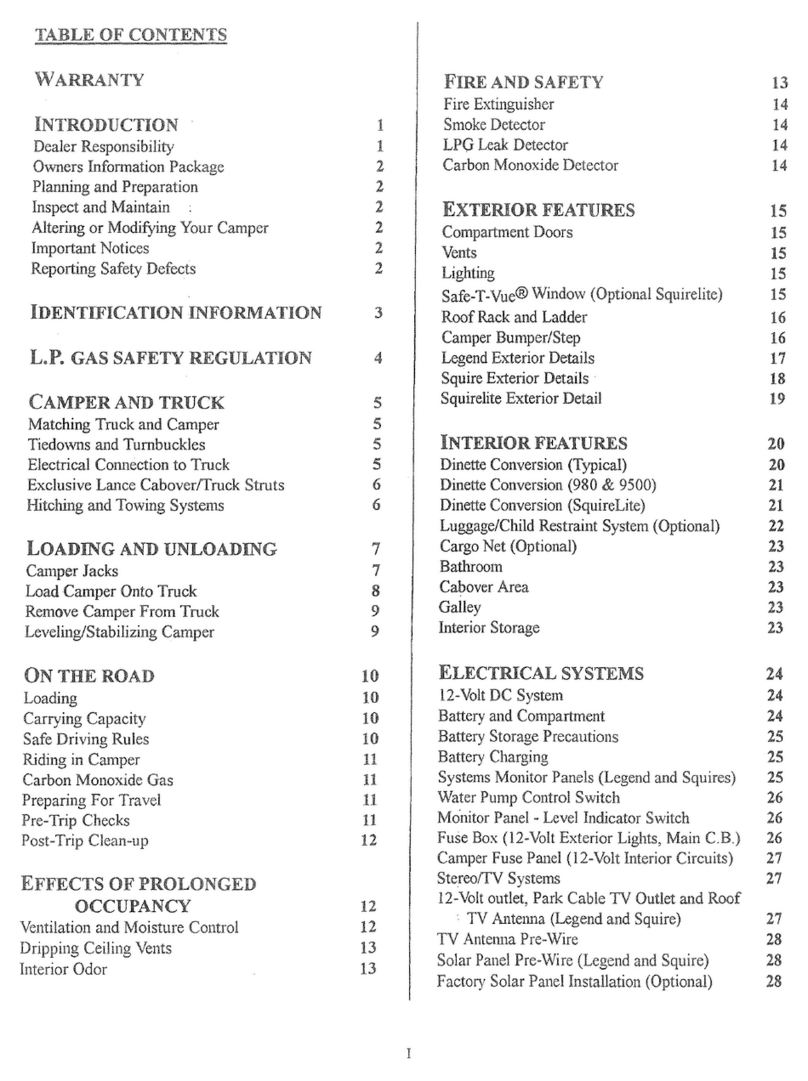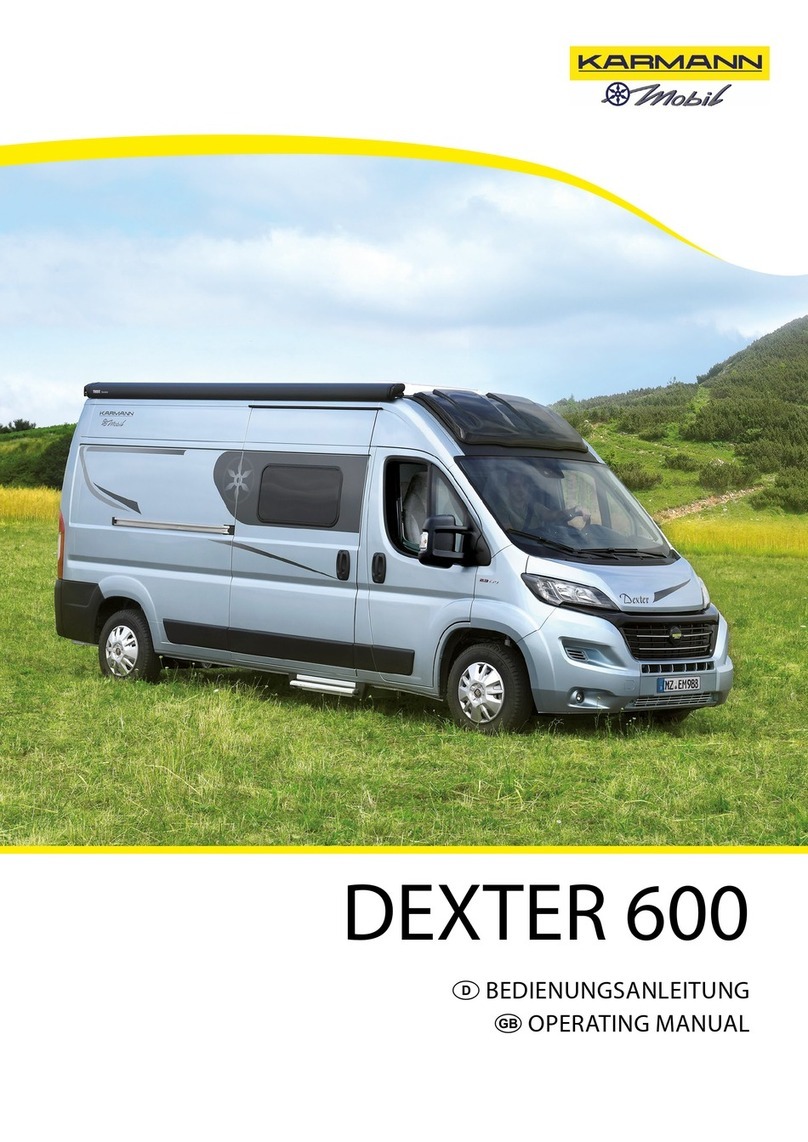Country Coach Inspire 360 User manual


---y
~l
~
')
~l
yo
~
')
~
')
~
~
~)
=)
:-j
:)
:J
:-)
:)
:)
~-)
:1
=-)
~-)
:1
=J
=J
=~
,J
)
:J
,J
~
~
=J
~-)
~
~)
~)
~J
~
,J
~
,j
Inspire
360
Before
Leaving
Before
Leaving
Exterior
1.1
Interior
1.2
Supplies
1.3
Walk-Around
Inspection
1.3
Engine
Operation
1.6
Backing
Procedure
1.8
Kwikee
Step
Operation
1.8
Smoke
and
Gas
Safety
1.9
Emergency
Exits
1.12
Traveling
Safely
1.12
Safety
Belts
1.12
Tire
Safety
1.15
Country
Coach
Tire
Inflation
Policy
1.18
Loading
the
Motor
Home
1.19
Towing
a
Vehicle
or
Trailer
1.23
Auxiliary
Brake
Requirements
1.25
Emergency
Towing
of
Your
Motorcoach
1.25
Dry
Camping
1.29

)
)
)
)
)
)
)
)
)
)
)
)
)
)
)
)
)
)
)
)
:)
:)
:)
)
· )
· )
)
· )
· )
) i
)
· )
· ) .
· )
:)
, )
)
)
)
· )
)
)
)
)

-J
~-)
.--)
~)
-l
r~)
~)
'}
~
r-)
.
~
~J
~)
=-)
~)
:J
-)
~
)
~)
~~)
:)
')
~')
r)
-)
'.-)
:_J
~)
:-)
~
~J
....
)
~J
~J
.~
~J
~~)
~
..
~
,.J
-)
~)
,.J
.~)
BEFORE
LEAVING
Note: The letters
FE
refer to information unique to the Inspire 360 Founder's Edition.
Check the following items before leaving on a trip:
Exterior
• Check
for
cracks, chips,
or
other obstructions in mirrors, windows, and lenses.
• For additional safety, turn
off
the gas valve on the LP
tank
(this disables all
of
the gas-powered appliances,
except
the
refrigerator, which can also be
operated electrically).
• Disconnect and store the
power
cord. Disconnect the television cable,
telephone line,
city
water
supply, and
sewer
system connection. Be sure all
sewer compartments, storage
compartment
doors, and fuel
compartment
doors
are closed and secured.
• Check fluid levels, including engine oil, battery water, radiator coolant,
transmission fluid,
power
steering fluid, and hydraulic fluid. Refer
to
the
Chassis part
of
this
manual
for
information on checking fluid levels.
• Check the battery tray(s)
to
be sure
they
are locked in place.
• Check the storage areas
to
be sure all items are adequately secured.
• Check the (optional) storage roll-out tray(s)
to
be sure
they
are secured.
Make sure
bay
doors
are closed, latched, and locked.
• Be sure the computer-assisted leveling system is in travel mode.
!
WARNING
Before
moving
your
coach,
the
green
Travel
indicator light
must
be
on.
Do
NOT
move
the
coach
until
the
HWH
leveling
system
is
in
Travel
mode.
• Inspect the area around and under the coach
for
obstructions, including the
fender well areas. Inspect
for
correct travel height. Retract slide-out rooms,
if
applicable. Always
check
behind the coach before backing; use a
spotter
if
necessary.
• Remove any wheel
chocks
.
• Retract, secure, and
lock
awnings in the travel position.
• Go
to
the front
of
the coach, and
check
that
both
of
the low-beam
headlights turn on and
both
of
the four-way hazard flashers are working.
Inspire
360
Before
Leaving
House
1.1

Inspire
360
Before
Leavi,ng
1.2
House
This
would
be a
good
time
to
verify
that
both
turn
indicators
are functional.
• Pull the headlight
dimmer
switch
and verify
that
the
high-beam lights are
working. Turn
off
the
headlights and
four-way
hazard flashers.
• Turn on the parking, clearance, side marker, and identification lights.
• Make sure the hitch receiver
tube
is securely pinned
with
the retaining clip.
!
WARNING
Interior
Country
Coach
recommends
that
the
weight of
the
tow
load
NOT
exceed
10,000
pounds,
and
the
tongue
weight
not
exceed
600
pounds
within eight
inches
of
the
coupling.
Failure
to
observe
these
weight
recommendations
may
result
in
damage
to
the
vehicle
as
well
as
void
the
warranty for
such
damage.
• For safety,
deadbolt
the
entrance door.
• Close all
roof
vents. Traveling with the
roof
vents open creates a
suction
that
defeats the effectiveness
of
the over-the-road
air
conditioning and
heater.
• Be sure loose items in
the
refrigerator are secure,
the
door
is latched, and
all heavy items are
moved
to
the fixed shelving.
• Secure
pocket
doors.
• Secure all interior cabinet
doors
and drawers. Avoid putting heavy articles in
overhead cabinets;
they
may
fall
out
while traveling and cause injury.
• Clear items from
counter
and table tops, and store the sink and
stove
top
covers in
the
space
provided.
Even small
items
can
inflict
serious injury
during an
accident.
• Cooking while traveling is
not
safe -
hot
liquids
or
food
can cause injury
during a
sudden
stop.
• Lower any roof-mounted television antennas
or
satellite dishes.
•
Adjust
the mirrors and seats before departing.
• Check all dash gauges and warning lights
to
be sure
that
all
coach
systems
are functioning correctly.
• Check fluid levels
for
the
diesel fuel, and the hydraulic system, as well as
the fresh-, gray-, and
black-water
tanks.
• Check the operation
of
the brakes.
• Test the generator
for
proper
operation.
• Ensure all passengers are using safety belts before leaving.
)
)
)
)
)
)
)
)
)
)
)
)
)
)
)
)
)
)
)
)
)
)
)
)
)
)
)
)
)
)
)
)
)
)
)
)
)
)
)
)
)
)
)
)

· -)
-)
--)
')
~)
-l
~
~
~
)
~)
)
~
-j
-)
r)
~)
-.'J
.,J
--)
~)
~)
~)
:-)
~
)
~)
.J
:_J
~)
-)
-)
,)
~J
~J
--
)
=--)
~
:~
~)
.J
,-)
~J
.J
J
Supplies
Keep the following supplies
in
the coach
in
case of
an
emergency:
• Typical emergency road kit, including flares, reflective triangles, an
inexpensive 12 VDC test light, a digital multimeter, spare fuses and light
bulbs, and a first aid
kit
• Tool
box
containing screwdrivers
of
various
types
and sizes,
open-
or
box-
end
wrenches
14"
to
1",
vise
grips,
wire
cutters,
crimpers
and
strippers,
pliers,
adjustable
wrenches,
black
electrical
tape,
duct
tape,
and
an
assortment
of
nylon
cable
ties.
A
good
pair
of
work
gloves is also a useful
and welcome addition
to
any tool kit
• Tow cable
or
chain, 20,000 lb. minimum pull strength
• Four
quarts
of
transmission fluid and
eight
quarts
of
motor
oil
• One gallon propolyne glycol antifreeze/coolant
for
engine
cooling
system,
such as Fleetguard
ES
Compleat
• Flashlight
with
extra
batteries
• 2S-foot
potable
water
hose
• Extra
black-water
tank
chemicals
• Wooden "strike-anywhere"
matches
• A long-handled squeegee, a long funnel, and a two-gallon plastic bucket
Walk-Around
Inspection
General
• Walk around and
inspect
the
overall
condition
of
the
coach.
• Clean all lights, reflectors, and glass.
•
Check
all wheels and rims:
-Condition of wheel and rim: no sign of misalignment, no missing, bent,
or
broken studs or lugs. Damage
to
rim edges may develop into cracks later.
-Use a wrench
to
test rust-streaked lug nuts; this may indicate looseness.
- Make sure lug-nut covers are securely fastened. Check tires and see
that
the pressures are set
to
the tire tag specifications.
(See
also Country Coach
Tire Inflation Policy later
in
this chapter.) Check tires
for
wear and damage.
• Tires -
check
for:
-Proper inflation -
to
tire tag specifications (Also see
Country
Coach
Tire
Inflation
Policy
later
in
this chapter)
-Unusual appearance
of
the tread
or
sidewalls, such as separation at seams,
bead, in between tread ribs,
or
bulges in the sidewalls
Inspire
360
Before
Leaving
House
1.3

Inspire
360
Before
Leaving
1.4
House
-Road debris, rocks, pieces
of
metal,
or
other
foreign objects
wedged
into
the
treads and between
the
dual tires
-Valve stems and caps
OK
• Fuel
tank:
-
Not
damaged
or
leaking
-Cap(s} on and secure
-Overflow valve vent
tube
damage-free and
clear
of
obstructions
Left Front Side
• Driver's
windows
should
be
clean.
•
Door
latches
or
locks
should
work
properly.
•
Left
front
suspension:
-Shock absorber condition -have
worn
or
leaking
shocks
replaced.
•
Left
front
brake:
-Condition
of
brake hoses and connections -service
and/or
replace as
necessary.
Front
•
Condition
of
front
suspension
•
Condition
of
steering
system:
-No loose, worn, bent, damaged,
or
missing
parts
-With the engine off,
attempt
to
turn
the
steering wheel
to
test
for
looseness
in
the
system.
•
Condition
of
windshield/wipers:
-Check windshield
for
damage, and clean
if
dirty
-Check
wiper
arms
for
proper
spring tension
-Check
wiper
blades
for
damage,
stiff
rubber, and security.
If
dirty, clean with
special wipes designed
for
this
purpose.
•
Lights
and
reflectors:
-Headlights, parking, clearance, and identification lights are clean and operating.
-Reflectors are clean;
left
and right turn signals -clean and operating.
•
Mirrors
-
check
for:
-Damage
to
the
mirror housing
-Damage
to
the
glass
or
reflective surface
-Correct adjustment
for
proper visibility, prior
to
leaving
)
)
)
)
)
)
)
)
)
)
)
)
)
)
)
)
)
)
)
)
)
)
)
)
)
)
)
)
)
)
) i
)
)
)
)
)
)
)
)
)
)
)
)
)

-)
~)
-)
~
~
~)
~
')
~
~
~)
'=)
~
:-)
~)
~-)
~]
=)
~-)
')
:)
:)
~)
~)
:)
~)
~)
:J
~J
~)
C)
:J
~)
~
~J
~=>
:_J
~J
~)
-~
~J
--)
__
J
J
Right Front
• Driver's
windows
should
be
clean.
•
Door
latches
or
locks
should
work
properly.
• Right
front
suspension:
-Shock absorber condition -have worn
or
leaking shocks replaced.
• Right
front
brake:
-Condition
of
brake discs and hoses -service
and/or
replace as necessary.
Right and Left Rear
• Tires
same
size
and
type:
not
mixed
radial
and
bias
ply
• Wheel bearing/seals:
not
leaking
•
Check
engine belts and hoses
for
cracks
or
tears.
•
Check
for
foreign
objects
stuck
between
dual
tires.
• Suspension:
-Axles
not
leaking oil
-Worn
or
leaking shock absorbers
-Check
for
fluid beneath the coach suspension components
• Brakes:
-Any required service should
be
performed
by
qualified service
technicians only.
-Condition
of
hoses: look
for
cracks, leaks,
or
any wear due
to
rubbing
•
Lights
and
reflectors:
-Side-marker lights and reflectors: clean and operating
Rear
• Engine
compartment
-Rear
of
engine:
not
leaking
-Transmission: not leaking
-Exhaust system: secure,
not
leaking
or
touching wires
-Frame and cross members: no bends
or
cracks
-Air lines/electrical wiring: secure from snags, rubbing, and wear
Inspire
360
Before
Leaving
House
1.5

Inspire
360
Before
Leaving
Figure
1.1
Ladder
extension
attachment
1.6
House
• Lights and reflectors:
-Clearance and identification lights: clean, operating, and proper color
-Reflectors: clean and proper color (red at
rear)
-Taillights: clean, operating, and proper color (red at rear)
-Rear turn signal lights: clean, operating, and proper color (amber
or
red)
• License plate(s): clean, secured, lighted, and
up
to
date
• Splash guard(s):
properly
fastened,
not
damaged,
dragging
on
the
ground
or
rubbing
tires
Parking
Brake
Rear
Ladder
with
Universal
Extension
(option)
The optional rear ladder enables access to the roof and
the components found there, such
as
sky lights, vents,
antennas, and the air horns. To reach the main part of
the ladder, a "universal" extension
is
located
in
one of
the storage bays. As diagrammed
in
Figure 1.1, rotate
the extension to the horizontal position and slip the
C-shaped ends over the lower step of the main ladder.
Then lower the extension until it rests against the coach
at the bottom.
To
check
parking
brake
operation
(in an
open
and
clear
area):
1 Fasten safety belt.
2
Allow
the vehicle
to
move forward slowly.
3
Apply
parking brake.
If
the vehicle
does
not
stop,
the
parking brake
may
be
faulty and should be checked.
Engine
Operation
Before
Starting
the
Engine
• Perform the engine pre-trip inspection and daily maintenance checks as
required in
your
chassis owner's manual.
•
In
colder climates, it may be advisable
to
pre-heat the engine before starting.
Find the 120
VAG
plug
in
the
back
of
the coach, located near the trailer
hitch. Plug it into a standard household 120
VAG
outlet.
GFGI
protection on
that
outlet would be prudent as the heater would typically be operated in an
outdoor
environment. The
block
heater
power
requirements are 120 volts,
1500 Watts, at 12.5 amps, about the same as a typical hair dryer.
)
)
)
)
)
)
)
)
')
)
)
)
)
)
)
)
)
)
)
:)
)
:)
)
~
)
~
)
:)
c )
)
)
)
)
, )
)
, )
)
)
)
)
)
)
)
)
)

)
)
)
~J
~-)
--)
~)
~l
')
~l
~)
--)
-)
-)
-)
-)
~
)
)
~
)
)
)
)
~
)
:)
~
)
:)
:)
~)
-)
:)
:)
~:J
:J
,J
~J
,J
:-)
~)
~-)
__
J
,J
_J
_J
J
The heater should be
plugged
in
for
at
least 2 hours before
attempting
an
engine start. The coolant
temp
gauge should rise
faster
than normal once
the engine
is
started.
• Ensure all
occupants
take
their
seats and
buckle
their
safety belts.
• Turn off the headlights and accessories.
Starting
Your Engine
1 Turn the ignition switch
to
on, and make sure
that
the transmission is in
neutral
(N),
and the parking brake is set.
2 Rotate
the
key
clockwise
to
the
start position. When
the
engine starts, let
go
of
the key. The idle speed reduces as the engine warms.
!
CAUTION
Do
not
crank
the
engine
for
more
than
30
seconds
at a time; wait
two
minutes
after
each
try
to
allow
the
starter
to
cool.
Failure
to
do
so
could
cause
starter
damage.
! WARNING
Do
NOT
drive
the
unit until
the
oil
pressure
gauge
reading
is
normal.
If
there
is
no
oil
pressure
indicated
on
the
oil
pressure
gauge
in
the
dashboard
display,
shut
down
the
engine
immediately
to
prevent
serious
damage.
Do
not
operate
until
the
cause
of
the
problem
has
been
corrected.
Engine Break-In Period
Your engine must pass a full-load operation test on a dynamometer before shipment
from the chassis manufacturer, thereby eliminating the need for
an
extended break-in
period. Only
an
initial operational check
is
necessary. Proper operation and
maintenance
are
key factors
in
obtaining the maximum life and economy from your
vehicle engine. Please follow the directions
in
your chassis operation and maintenance
manual for trouble-free engine operation.
Engine
Shutdown
1 With
the
vehicle stopped,
apply
the parking brake and reduce the engine
speed
to
low
idle.
2 Place the transmission range selector in N (Neutral).
3 Turn off the ignition key
to
shut
down
the engine.
Inspire
360
Before
Leaving
House
1.7

------------------_._--------
Inspire
360
Before
Leaving
1.8
House
Service
Brakes
To
check
service
brake
operation:
1 Check
that
the
system air pressure gauge is indicating
the
minimum
required
air
pressure (85 psi)
2 Travel
about
5 mph;
apply
the
brakes.
3 Push brake pedal firmly.
"Pulling"
to
one side
may
mean brake
adjustment
is required.
Any unusual brake pedal "feel", noises,
or
delayed
stopping
may
indicate
further inspection
of
the brake system is required.
Backing
Procedure
Use
care
when
backing
your
coach:
• Check
for
obstructions
behind the coach.
• Check the entire backing route
for
obstacles.
• Watch the
backup
monitor
to
ensure a clear backing route is available.
Use
another person
as
a spotter! (Small
2-way
radios
or
a cellphone
for
passenger-to-driver
communication
are helpful in
this
instance.)
Kwikee
Step
Operation
The following table outlines the operation of your coach's entry step.
!
CAUTION
Watch
your
step
when
entering
or
exiting
your
coach.
Before
operating
the
step,
be
sure
there
are
no
external
obstructions
that
would
prevent
extending
the
step
safely.
)
)
)
)
)
)
)
)
)
)
)
)
)
)
)
)
)
)
)
)
)
)
:)
~
)
, )
)
)
)
)
)
)
)
)
)
)
)
)
)
)
)
)
)
)
)

-l
~-)
-l
-y
~)
~
-j
~
=:-)
~l
~J
~
~)
--)
~)
~-)
~
)
:)
~)
~
)
:)
')
~)
.:)
')
, )
'J
~J
,)
~J
~J
:J
~J
~J
.~
~J
:-)
:~
~
~)
.J
,)
.J
~)
Figure
1.2
Figure
1.3
LP
gas
tank
(Inspire
360)
LP
gas
tank
(Inspire
360
FE)
Smoke
and
Gas
Safety
LP Gas
Information
!
WARNING
•
Do
NOT
place
LP
gas
containers
inside
the
vehicle.
LP
gas
containers
are
equipped
with
safety
devices
that
relieve
excessive
pressure
by
discharging
gas
to
the
atmosphere.
• It
is
NOT
safe
to
use
cooking
appliances
for comfort
heating.
Cooking
appliances
need
fresh
air circulation for
safe
operation.
Before
operation:
• Open overhead vents
or
turn on the exhaust fan (not
to
include microwave
fan).
• Open a
window
to
provide an adequate
supply
of
fresh air. Unlike houses,
the
oxygen
supply
in a
motorcoach
is limited. Proper ventilation when
using
the
cooking
appliance(s) helps prevent
danger
of
asphyxiation. The
danger
of
asphyxiation increases as
cooking
appliances
are used
for
longer
periods
of
time.
!
WARNING
•
Do
Not
fill
container(s)
to
more
than
80%
of
capacity.
Overfilling
the
LP
gas
container
may
result
in
uncontrolled
gas
flow
which
can
cause
fire
or
explosion.
Inspire
360
Before
Leaving
House
1.9

Inspire
360
Before
Leaving
Figure
1.3
LP
gas
detector
1.10
House
! WARNING
•
Portable
fuel
burning
equipment,
including
wood
and
charcoal
grills
and
stoves,
should
NOT
be
used
inside
the
coach.
Doing
so
may
cause
fire
or
asphyxiation.
•
Do
not
store
LP
gas
containers,
gasoline
or
other
flammable
liquids
inside
the
vehicle:
fire
or
explosion
may
result.
•
To
respond
to
the
smell
of
gas:
1
Extinguish
all
open
flames,
pilot
lights,
and
smoking
materials.
2
Do
NOT
use
electrical
switches.
3
Shut
off
the
gas
supply
at
the
tank
valve(s)
or
gas
supply
connection.
4
Open
doors
and
other
ventilation
openings.
5
Leave
the
area
until
the
odor
clears.
6
Have
the
gas
system
checked
and
leakage
source
corrected
before
using
it
again.
LP Gas Detector
The
LP
gas detector (Figure 1.3) alerts coach occupants to the presence of free
gas within the coach. Since
LP
gas
is
heavier than air and the gas powered
appliances are clustered
in
the kitchen area, the detector
is
located near floor level
within the kitchen.
The
LP
gas detector receives power from the house
battery through a circuit protected by a 3-amp fuse.
The
detector draws
very
little energy and continues to
operate until the battery
is
drained to
as
low
as
7 volts.
If
the supply battery
is
drained below this, the detector
cannot be reset until the battery charge
is
restored to a
minimum of 10
VDC.
When the gas detector
is
switched
on
(whenever power
is
supplied to the coach
interior) the green "Operating"
LED
illuminates. There
is
then a 60-second delay
before the unit begins monitoring for any combustible vapors. When gas
is
detected
by the sensor, a pulsating alarm sounds, and the red "Alarm"
LED
illuminates.
The alarm does not go off until either the gas
has
dissipated or the Mute button
is
pressed. However, if gas
is
still present, the alarm returns after 60 seconds.
! WARNING
When
the
alarm
sounds,
open
all
available
windows
and
doors
to
ventilate
the
area,
and
turn
off
the
gas
at
the
tank.
Do
NOT
re-enter
the
affected
area
until
the
alarm
stops
sounding.
)
. )

-]
~)
~)
~
)
~
~
)
~
~
)
~
)
)
~-)
~
-)
~)
')
=)
rl
~)
=J
==)
~)
=)
r)
~)
:)
:-)
~
~
~J
r)
=J
~
~
~J
~
'-J
~
~)
~J
_J
rJ
If
the
LP
gas detector has not been used for a long period
of
time, or the power
source has been disconnected, the alarm sounds. Reset by switching the detector
off for a few seconds, then back
to
the on position.
If
the alarm continues after two or three resets, follow these steps:
1 Check the battery to be sure
it
is
sufficiently charged.
2 Air out the coach and fan the sensor
in
the gas detector. The detector
is
also sensitive to fumes such as alcohol, hair spray, carbon monoxide,
deodorants, and some cleaning agents.
3 If the alarm continues to sound, have a qualified
LP
gas dealer or
RV
service center test for gas leaks and make necessary repairs.
!
NOTICE
A
manual
shutoff
valve
to
the
cooktop
has
been
incorporated
into
the
LP
gas
line
and
is
located
below
this
unit.
For more information, see
the
LP
gas detector card located
in
your Coach
Information Kit.
Fire Safety Devices
For your safety and convenience, Country Coach installs at least one dry-chemical
type fire extinguisher
(Class
1:10
BC),
one battery-powered smoke detector, and one
hard-wired carbon monoxide detector as standard equipment.
The fire extinguisher
is
located near the entry door. The smoke detector
is
mounted
within the galley/dinette area and the carbon monoxide detector
is
installed
in
the
dinette area.
All
of these safety devices have instructions for inspection, maintenance, and use
printed
on
their labels. For your safety, it
is
strongly suggested that you become
completely familiar with each device.
Carbon Monoxide Detector
Carbon monoxide
(CO)
is
a very dangerous gas that
is
odorless,
colorless, tasteless, and nonirritating.
For
your safety and convenience,
all
Country Coach motorcoaches come equipped with a carbon monoxide
detector
(Figure
1.4).
This solid-state infrared sensor device
is
typically mounted
on
the
underside of the cabinets or
on
a wall near mid coach.
It
has a standard
9-volt battery
as
backup
in
case power to the device
is
cut off.
Operation:
Inspire
360
Before
Leaving
Normal:
Red LED flashes every 30 seconds, indicating operation.
Figure
1.4
Alarm:
Red LED flashes and pulsating horn sounds.
Carbon
monxide
detector
(typical)
Trouble/Service:
Red LED flashes and horn beeps once every 30 seconds.
House
1.11

Inspire
360
Before
Leaving
1.12
House
Test: One beep, followed
by
LED flashing 4 to 5 times, followed
by
2 alarm
signals.
Test
the CO detector weekly.
For
more information,
see
the carbon monoxide detector information located
in
your
Coach Information
Kit.
!
NOTICE
It
is
very
important
that
the
CO
detector
be
tested
after
the
coach
has
been
in
storage,
before
each
trip,
and
at
least
once
each
week
during
use.
See
the
carbon
monoxide
detector
information
for
complete
testing
procedures.
Emergency
Exits
Recreational vehicles
are
required to
have
a minimum of two emergency
exits.
Please
take the time to
familiarize
yourself with the alternate emergency exit located
in
the
rear bedroom on the driver's side.
Note:
It
is
clearly identified
as
EXIT.
It
is
equipped with either one or two handles that
are
colored red. To gain egress,
you must either pull or twist the handle(s), then push out the window.
Traveling
Safely
Your unit was designed to be open and spacious. While this provides delightful
aspects to traveling, it also requires additional safety awareness.
All
loose objects
can become potentially dangerous projectiles
in
the event of sudden stops and
maneuvers. To eliminate this hazard, be sure
all
loose objects are properly secured.
Closets, drawers, and cabinet doors are provided with latches for this purpose.
Before each trip, check
all
open areas to verify that gear has been properly
stowed. Check
all
appliances, doors,'and drawers for proper locking or latching.
All
passengers should sit
in
designated seating areas only. Fasten the safety belt by
engaging the buckle, and adjust the belt by pulling the excess through the clamping
mechanism at the buckle. The belt should
be
snug, with the buckle positioned for
your comfort and easy access.
Safety
Belts
Due
to the unique configuration of recreational vehicles, not
all
seating positions
are equipped with safety belts. Those seats not equipped with safety belts should
not be occupied while the vehicle
is
in
motion. Since these are not equipped with
safety belts, they provide no protection
in
the event of a sudden stop, maneuver,
or
an
accident.
While
in
transit,
all
occupants must sit
in
seats equipped with safety belts.
For
your
own safety, do not get up
and
move around the coach while it
is
in
motion.
The following instructions describe how to wear safety belts properly.
(See
Figure
1.5,
page 1.13)
)
)
)
)
)
)
)
)
)
)
)
)
)
)
)
)
)
)
)
)
)
)
)
. )
)
)
:)
)
)
)
)
)
)
)
)
)
)
)
)
)
)
)
)
)

~l
-)
")
~)
')
)
~J
)
~)
~}
~
~)
J
~)
~)
~J
=J
)
~)
~-)
~
)
c )
=)
~
)
~)
=]
F)
~cJ
~)
_J
~)
~J
~J
~J
~_J
~J
~cJ
,-)
~J
-)
,~
:J
_J
,J
To
use
the
lap/shoulder
safety
belt:
1 Close and
lock
the entry door.
2
Adjust
the
seat
so you can sit
up
straight.
3 Pull the belt across you.
Don't
let
it
get
twisted.
4 Push the latch plate into the buckle until
it
clicks. If the belt
stops before it reaches the buckle, tilt the latch plate and keep
pulling until you can buckle it. If the belt is not long enough, see
the Safety Belt Retrofit section (pg. 1.15).
5 Make sure the release button on
the
buckle faces
upward
or
outward so you would be able
to
unbuckle
it
quickly,
if
necessary.
!
WARNING
Atwisted belt
can
seriously
injure
you.
In
a
crash,
you
wouldn't
have
the
full width of
the
belt
to
spread
impact
forces.
If a belt
is
twisted,
make
it
straight
so
it
can
work properly
or
ask
your
dealer
to
fix it.
To
unlatch
the
belt,
push
the
button
on
the
buckle.
The
belt
should
retract
out
of
the
way.
6 Wear the belt low and snug on the hips,
just
touching the
thighs. In a crash, this technique applies force
to
the strong
pelvic bones and you are less likely
to
slide under the lap belt.
If
you were
to
slide under it, the belt would
apply
force
to
your
abdomen. This could cause serious
or
even fatal injuries.
7 Press the red colored button on the buckle to unlatch the belt.
!
CAUTION
Children
There
are
special
things
to
know
about
safety
belts
and
children.
And
there
are
different
rules
for
babies
and
smaller
children.
If a child
is
riding
in
your
coach,
refer
to
the
section
for
children.
Follow
the
instructions
there
for
everyone's
protection.
Everyone
in
the motorcoach needs protection! That includes infants and
all
children smaller than adult size.
In
fact, the law
in
every U.S. state and
Canadian province specifies that children beyond a specific age and
weight must be restrained while
in
a vehicle.
Inspire
360
Before
Leaving
Correct seat belt placement
Lap belt worn low across hips and
shoulder belt placed properly
on
shoulder.
Incorrect seat belt placement
Belt should never be worn
with the shoulder belt
behind the back.
Incorrect seatbelt placement
Shoulder belt should never
be
worn across chest and under arm.
Figure
1.5
Proper
use
of
seat
belt
House
1.13

Inspire
360
Before
Leaving
1.14
House
Smaller Children and Babies
Smaller children and babies should always be restrained
in
a child or infant restraint.
The instructions for the restraint note whether it
is
the correct type and size for your
child. A very young child's hip bones are so small that a regular belt does not properly
stay low on the hip. Instead, the belt ends up over the child's abdomen.
In
a crash,
the belt would apply force over the child's abdomen, which could cause serious or
fatal
injuries.
Be
sure that any child small enough for one
is
always properly restrained
in
a child or infant restraint.
!
WARNING
Never
hold
a
baby
in
your
arms
while
riding
in
a
vehicle.
A
baby
doesn't
weigh
much
-
until
a
crash.
During
a
crash
a
baby
becomes
so
heavy
you
can't
hold
it.
For
example,
in
a
crash
at
only
25
mph
(40
km/h),
a
12-pound
(5.5
kg)
baby
suddenly
becomes
the
equivalent
of
250
pounds
(110
kg)
on
your
arms.
Result:
The
baby
would
be
almost
impossible
to
hold.
Always
secure
the
baby
in
an
infant
restraint.
Child restraint systems are designed to be secured
in
the vehicle by lap belts and
should
be
secured
in
accordance with the restraint system manufacturer's instructions.
!
NOTICE
Never
allow
two
children
to
wear
the
same
belt.
The
belt
can't
properly
spread
the
impact
forces.
In
a
crash,
the
two
children
can
be
crushed
together
and
seriously
injured.
Only
one
person
must
use
a
safety
belt
at
a
time!
Larger Children
The vehicle's safety belts should be worn by children who have outgrown child
restraints. Accident statistics show that children are safer when belted
in,
but they
need to use the safety belts properly. Children who aren't buckled up can be thrown
out
in
a crash or can strike other people. Wherever the child sits, the belt should be
worn low and snug on the hips, just touching the child's thighs. This applies belt
force to the child's pelvic bones
in
a crash.
Safety Belt Use During Pregnancy
Like
all
occupants, expectant mothers
are
more likely to be seriously injured if they do
not wear safety belts. A pregnant woman should wear the
lap
belt
as
low
as
possible
throughout the pregnancy. The best way to protect the fetus
is
to protect the mother.
When a safety belt
is
worn properly, it
is
more likely that the fetus won't be injured
in
a crash. For pregnant women -
as
for anyone -the key
to
making safety belts
effective
is
wearing them properly.
)
)
)
)
)
)
)
)
)
)
)
)
)
)
)
)
)
)
)
)
)
)
)
)
)
)
)
)
)
)
)
)
)
)
)
)
)
)
)
)
)
,)
)
)

~)
~)
~~)
')
')
~)
~
~
~
~
~)
~)
~)
~)
~~)
r )
:J
~)
~~)
~~)
~)
~
)
~]
:)
~)
~J
~)
~J
~J
~J
~~)
~J
:J
:)
:~J
~_J
:~
~
~
-~)
-)
--)
_~J
J
Safety Belt Retrofit
If
the vehicle's safety belt fastens around you, use
it.
But if a safety belt
is
not long
enough to fasten, your motorcoach can be retrofitted with
an
extended-length safety
belt. Your dealer or other authorized Country Coach service center will order a
custom-length safety belt that works properly and comfortably for you. Be sure to
get extended safety belts for each seat you may occupy while traveling.
!
WARNING
Torn
or
frayed
belts
may
not
protect
you
in
a
crash.
They
can
rip
apart
under
impact
forces.
If
a
belt
is
torn
or
frayed,
replace
it
immediately.
The
model
number
on
the
replacement
belt
must
be
listed
on
the
safety
belt
you
want
to
replace.
Checking Your Restraint System
Periodically, make sure
all
your belts, buckles, latch plates, retractors, and anchorage
are
working properly. Look for any loose parts or damage.
If
you see anything that
might keep a restraint system from doing its job, have it repaired or replaced.
Replacing Safety Belts After a Collision
After a very minor collision, your safety belts may still be
in
good working condition.
But if the belts were stretched,
as
they would be if worn during a more severe
accident, then new belts may
be
required.
If
belts
are
cut or damaged, replace them.
Collision
damage may also
mean
you need to have safety belt parts, like the retractor,
replaced or anchorage locations repaired,
even
if the belt wasn't being used at the
time of the collision.
Contact your selling dealer or authorized Country Coach service center for
assistance
in
replacing the safety belt.
Traveling with Pets
Traveling with the family pet may be enjoyable but
RVs
are typically not equipped
to
properly secure them.
In
an
accident, unrestrained pets
in
the coach can be thrown
around and become injured
as
well
as
injure other occupants. Specialty pet supply
stores carry safety belts for some varieties of pets.
Tire
Safety
The tires selected for your motorcoach
are
a very complex and precisely-engineered
product. To obtain the maximum
safe
use
and best service out of your tires, it
is
helpful
to understand the function of the tire.
It
is
the combination of pressurized air and the
tire's structural elements
(sidewall,
belts,
etc.)
that supports the
vehicle
and
its
contents.
In
addition, since the tire
is
the only contact that the vehicle has with the road
surface, it must perform other functions such
as
traction for moving, stopping, and
steering,
as
well
as
provide a cushion for the vehicle.
Inspire
360
Before
Leaving
House
1.15

Inspire
360
Before
Leaving
1.16
House
The
Importance
of
Air
Pressure
The most important factor
in
maximizing the life
of
your tires
is
maintaining proper
cold-tire inflation pressures. Driving
on
any
tire that does not have the correct
inflation pressure for the load of the vehicle
is
dangerous and may cause premature
wear, tire damage, and/or loss of control of the vehicle. Maintaining correct tire
inflation pressure
is
of the utmost importance and must be a part of regular vehicle
maintenance.
Under-inflation
causes a
buildup
of
excessive heat. Under-inflation
could
result in sudden tire failure. A tire
that
is under-inflated also causes
poor
vehicle handling, rapid tire wear, and a decrease in fuel economy.
Over-inflation
reduces the tire's footprint,
or
contact
point
with
the road,
thus
reducing vehicle traction, braking capacity, and road handling. A tire
that
is overinflated
for
the
load
that
it
is carrying also
contributes
to
a harsh
ride and uneven tire
wear
and is more
susceptible
to
impact
damage.
Federal
law
requires
that
the tire's maximum load rating be molded into the
sidewall
of
the tire. If you
look
there, you can see the maximum load allowed
and the
cold
air inflation pressure required
to
carry
that
stated
maximum
load. Less
air
pressure restricts the tire
to
carry a lighter load. For
your
safety, always adhere
to
the Federal Tire Label
for
proper inflation numbers.
When
to
Check
Air
Pressure
You should check your air pressure once a week when stationary and every day
while traveling.
If
your vehicle
is
stored for any length of time, air pressure should
be
checked prior to storage. More importantly, check the pressure when the coach
is
removed from storage.
Check
your
tires
when
they
are
cool.
The stated
cold
inflation pressure
is based on an
ambient
temperature
of
68°F.
Using
a
tire
gauge.
Country Coach recommends
that
you purchase a
quality
truck-style
air
pressure gauge. Some newer motorcoach wheels are
designed such
that
a normal
truck
tire gauge needs
to
have a bend in
it
to
reach the valve stem on the inside
of
the
outer
dual.
What
if
you
don't
check
your
air
pressure?
If you
pick
up
a nail
or
screw
while driving
that
creates a
slow
leak and causes some air pressure loss,
you might eventually
spot
it if
it's in a front tire
or
an
outer
dual. However,
if it
is an inner dual, the chances
of
spotting
it
without
an
air
pressure
check
are very slim. If you begin driving
without
finding it,
your
outer
tire is
going
to
heat up from carrying
double
its load
very
quickly
(in
most
cases,
within
a
few
miles) resulting in eventual
tire
failure. As you
"pretrip"
check
your
vehicle every "drive morning," include an air pressure
check
of
your
tires. Your safety is
worth
the extra
few
minutes!
)
)
)
)
)
)
)
)
)
)
1
)
)
)
)
)
)
)
)
)
)
)
)
)
)
)
)
)
)
)
)
)
)
)
)
)
)
)
)
)
)
)
)
)

-)
~)
)
~)
~l
~)
)
~
)
)
~-)
~-)
~-)
~~)
~-)
'-)
~
)
-)
:-)
-)
.)
~)
~)
=)
:)
:)
:J
~)
:J
=J
:J
-)
')
~
~~)
~
~
.:J
. )
~J
.)
.)
_J
J
Tire
Inspection
Your motorcoach tires should be inspected thoroughly at least once a year and
any time you drive
in
rough or rocky terrain, or
have
your coach serviced. This
inspection should include the outer and inner sidewalls, tread
area,
valve stems, and
caps. Inspect for
nails,
cuts, bulges, fatigue cracks, weathering, and ozone cracking.
Also, check the duals for objects lodged between them.
See
a tire dealer at once
if
there
is
anything found to
be
in
question. Your tires should be thoroughly inspected
by a tire expert at least once per
year.
!
CAUTION
Wheel
lug
nuts
must
be
retightened
to
proper
torque
specifications
(consult
your
chassis
owner's
manual)
at
50
miles
and
then
at
500
miles
of
new
vehicle
operation
(or
after
a
wheel
change)
and
at
the
intervals
specified
in
the
maintenance
schedule.
Failure
to
retighten
wheel
lug
nuts
as
required
could
allow
wheels
to
come
off
while
the
vehicle
is
in
motion,
causing
loss
of
control
and
possible
collision.
Changing
a Flat Tire
Even
the best drivers can drive over a
nail
and the best tires can pick up that
nail
or screw
and
go flat. Whenever this occurs, do not attempt to jack up the unit and
change it yourself. The motorcoach wheels and tires
are
extremely heavy and
lug
nut torque requirements make it advisable to summon professional help.
We
suggest
calling Coach Net or your auto club for assistance.
! WARNING
Your
coach
is
not
equipped
with
a
spare
tire
or
a
jacking
device.
Tire Repair
If you pick up
an
object that causes a flat with your coach tire, the repair must be
made to the inside of the tire. To do this, the tire needs to be dismounted and
inspected
on
the inside of the casing for any other damage that the object may
have caused.
In
all
cases, a service professional should remove a tire from the wheel
to inspect for internal damage.
Life
Span
of
an
RV
Tire Department
of
Transportation Tire size
code
Manufacturer
and plant code
Figure
1.6
Inspire
360
Before
Leaving
Date
of
manufacture
(3rd week
of
2007)
Optional
manuafacturer
symbols
Miles alone do not measure the
life
of a tire used
on
an
RV.
Your motorcoach tire
life
depends
on
driving habits, driving conditions, geography and
the age of your tires. You can determine the age of
the tire by looking at the
DOT
number
(Figure
1.6)
molded
on
the side
wall
of the tire. The last two
digits
on
the right
are
the last two digits of the year
in
which it was manufactured.
DOT
number
on
tire
sidewall
House
1.17
This manual suits for next models
1
Table of contents
Other Country Coach Motorhome manuals





